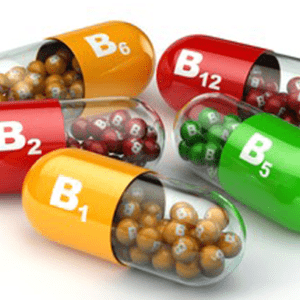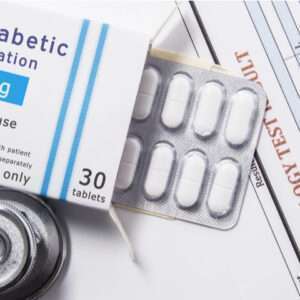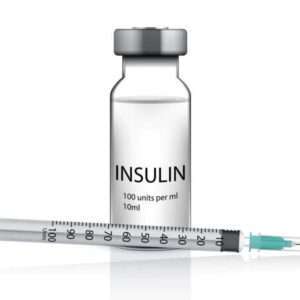Description
Oral antidiabetics: A comprehensive guide
Diabetes is a chronic disease that affects millions of people around the world. It’s an illness characterized by high blood sugar levels and can lead to serious health problems such as heart disease, stroke and blindness if left untreated. Oral anti-diabetic drugs (OADs) are medications used to treat or prevent diabetes mellitus type 2 in adults with inadequate glycemic control from diet and exercise alone. These drugs lower blood glucose levels by stimulating insulin production, decreasing glucagon secretion, delaying carbohydrate absorption from the gut and increasing pancreatic beta-cell responsiveness to glucose stimulation.
A range of oral medications is available for use, including metformin, sulfonylurea, thiazolidinediones (TZDs), alpha-glucosidase inhibitors (AGIs) pramlintide acetate. The choice will depend on personal preference as well as the severity of the condition being treated. The most common oral anti-diabetic drug is metformin, which blocks glucose production in the liver and works primarily on muscle cells rather than pancreatic beta cells.
Pharmapk is committed to producing high-quality chemicals. We know how critical it is to maintain our high standards; therefore, we put tremendous effort into ensuring that each batch of medications leaves our facility is excellent. We have Oral antidiabetics in stock and are available to ship anywhere in the world. Oral antidiabetics is available at a low cost from our business. We’re the best people to buy it from.
Oral antidiabetics: Different types and forms
Oral anti-diabetic agents are classified into insulinotropic and noninsulinotropic groups. The difference between the two types of drugs is that insulinotropic medications work by stimulating tissue-specific insulin receptors to release insulin in response to glucose levels in the blood. In contrast, Noninsulinotropic agents do not affect the secretion of either endogenous or exogenous insulin. Non-insulinotropic drugs are usually combined with basal or short-acting insulin to help reduce hyperglycemia during periods of excessive glucose production, such as following surgery, trauma, infection, or pregnancy. Insulinotropic include sulfonylureas and meglitinides, while examples of noninsulinotropic agents include metformin, acarbose, miglitol, voglibose, and thiazolidinediones.
Oral antidiabetics: Side effects, risks and complications of overdose
Oral antidiabetics lowers the risk of complications from diabetes such as kidney disease and nerve damage. These medications have been shown to reduce the risk of heart attack or stroke by up to 30%. However, oral anti-diabetic drugs also have side effects that you should be aware of before taking them. For example, they can cause your body’s potassium levels to drop too low. This may lead to hypokalemia, which could impact both your kidneys and heart function if left untreated. One common side effect is that weight gain can occur with some oral diabetes medications because they stimulate insulin secretion, increase appetite, and slow metabolism. Other possible side-effects include nausea, diarrhoea, skin rashes and hair loss for those who take sulfonylureas (like glyburide)
It is important to tell your doctor about any other medications you take because some over-the-counter medications – such a nasals decongestants – may affect how well your oral anti-diabetic drug works. Also, it would be best to tell your doctor about any other medical conditions you have, as certain conditions may affect the drug’s effectiveness. In addition, this medication might be less effective if you have uncontrolled or severe cases of certain conditions, including heart failure, obesity, pancreatic cancer or hepatitis.
When oral antidiabetics are ingested in large quantities, they may cause hypoglycemia. There are many complications associated with overdose, including coma, seizures and death.
Qualitative and Quantitative dosage form and strength.
Metformin
Immediate-release tablets
- 500mg contains 500mg metamorfin per Immediat-release tablet.
- 850mg contains 850mg metamorfin per Immediate-release tablet.
- 1000mg contains 1000mg metamorfin per Immediate-release tablet.
Extended-release tablets
- 500mg contains 500mg metamorfin per Extended-relase tablet.
- 750mg contains 750mg metamorfin per Extended-release tablet.
- 1000mg contains 1000mg metamorfin per Extended-release tablet.
Oral solution
- 100mg/ml contains 100mg metamorfin per ml oral solution.
Oral suspension
- 500mg/5ml contains 500mg metamorfin per 5ml oral suspension.
Glimepridie (sulfonylureas)
Tablets
- 1mg contains 1mg glimepridie per tablet.
- 2mg contains 2mg glimepridie per tablet.
- 4mg contains 4mg glimepridie per tablet.
Glyburide (sulfonylureas)
Oral Tablets
- 25mg contains 1.25mg glyburide per tablet.
- 5mg contains 2.5mg glyburide per tablet.
- 5mg contains 5mg glyburide per tablet.
Microzined Tablets
- 5mg contains 1.5mg glyburide per micronized tablet.
- 3mg contains 3mg glyburide per micronized tablet.
- 5mg contains 5mg glyburide per micronized tablet.
- 6mg contains 6mg glyburide per micronized tablet.







Reviews
There are no reviews yet.